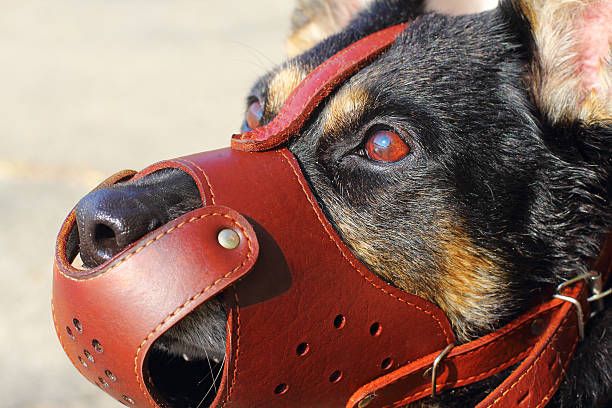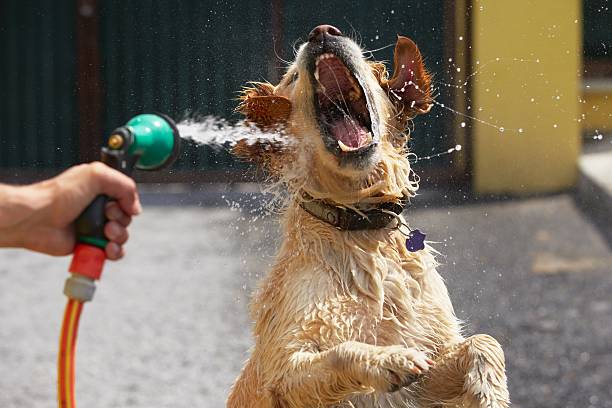1. Using Harsh Leashes and Chains

When it comes to our beloved canine companions, our understanding of how they learn and what they need has evolved dramatically. Methods once considered standard are now seen as not only ineffective but harmful, replaced by approaches rooted in respect, positive reinforcement, and emotional well-being.
In earlier decades, dogs were often trained using heavy chains or thick leather leashes designed to restrict movement rather than guide it. The belief was that a dog learned obedience through physical correction, not communication or positive reinforcement. Pulling, jerking, and tightening were considered normal ways to demand attention and compliance. Today, these methods are widely recognized as stressful and damaging, both physically and psychologically. Modern training emphasizes connection, engagement, rewards, and trust-building. The shift reflects a broader cultural change: dogs are no longer seen as property to be controlled, but companions with emotional lives and learning needs.
2. Alpha Rollovers to “Show Dominance”

The alpha rollover involved forcibly pinning a dog onto its back to “prove” who was in charge. Popularized by outdated interpretations of wolf behavior, this method assumed dogs only learned through submission. In reality, this approach caused fear, confusion, broken trust, and sometimes defensive aggression. Modern animal behavior science reveals that cooperative learning, clear routines, and predictable communication build far stronger and more consistent behavior. The alpha concept was based on observing stressed wolves in captivity, not natural social behavior. Today, this tactic is considered unsafe and harmful, and it is discouraged by every major training and veterinary organization.
3. Shock Collars as First-Line Training Tools

Shock collars were once marketed as efficient, “silent” teaching devices that allowed humans to correct behavior from a distance. They were widely used in hunting dog training and general obedience work. Over time, it became clear that shock-based training often suppressed behavior through fear rather than teaching understanding or long-term reliability. Dogs trained this way sometimes became anxious, withdrawn, or unpredictable under stress. Modern training focuses on shaping wanted behavior through positive reinforcement rather than punishing unwanted behavior. Some regions have now banned shock collars completely, recognizing the ethical and emotional harm they can cause.
4. Forced Isolation to “Teach Manners”

Dogs who barked, jumped, or acted playfully were once shut away in barns, cellars, or outdoor pens to “calm down.” The assumption was that deprivation of social contact would teach obedience. In reality, isolation increases stress, anxiety, and behavioral issues, because dogs are social animals who learn from interaction. Today, trainers understand that dogs require structured engagement, consistent feedback, and opportunities to practice calm behavior, not punishment through separation. The shift represents an understanding that emotional needs influence behavior as much as physical ones. Isolation didn’t teach manners, it taught loneliness and distrust.
5. Muzzle-Based Punishment

Muzzles were once used not as safety tools but as punishment, placed on dogs for barking, growling, or attempting to guard. This ignored the reasons behind the behavior and removed the dog’s ability to communicate discomfort, fear, or warning. Modern training recognizes that growling is a communication tool, not misbehavior. Muzzles today are used responsibly: to keep dogs and people safe during gradual desensitization or medical handling, never as punishment. The shift signals a larger change: we now value understanding the cause of behavior instead of suppressing the symptom.
6. Tying Dogs on Short Chains for Long Hours

It was once common to keep dogs tethered outdoors for most of the day, especially in rural or working communities. This prevented wandering but deprived dogs of enrichment, exercise, and social contact. Long-term tethering creates frustration, stress, and can lead to defensive aggression. Modern laws in many regions now prohibit extended tethering, requiring secure yards, indoor companionship, or supervised outdoor time. The change reflects recognition that dogs experience emotional distress when physically restrained without social connection. A dog tied in place is not contained, it is isolated.
7. Rubbing a Dog’s Nose in Messes

Many people once believed that rubbing a dog’s nose in urine or feces would prevent future accidents. In reality, dogs do not associate the punishment with the behavior that happened minutes earlier, they associate it with the person administering it. This technique breaks trust while providing no useful learning. Modern house training focuses on structure, predictable routines, praise for correct elimination, and managing access to space. The shift acknowledges that dogs learn through association and support, not shaming or fear.
8. Loud Yelling or Startling as Correction

Shouting, banging objects, or startling dogs was once considered a way to “interrupt bad behavior.” While startling can momentarily stop an action, it does not teach what to do instead. Dogs may begin responding with fear-based compliance, hypervigilance, or avoidance of their handlers. Today’s training highlights calm communication, pattern-building, and positive reinforcement. Loud correction disrupts emotional stability, while quiet, consistent instruction strengthens it. The old approach creates a nervous partner, whereas the new one builds a confident companion.
9. Use of Prong Collars as Everyday Tools

Prong collars were designed to apply pressure to a dog’s neck when they pulled. While some trainers still defend their specialized use in experienced hands, widespread casual use has been strongly discouraged. The collars can cause both physical harm, potentially damaging the trachea or thyroid, and stress-based behavioral issues when misused because the dog learns to fear pulling. Modern leash training centers on engagement, pacing, body awareness, and reward-based redirection using comfortable harnesses or flat collars. The shift reflects a deeper respect for how dogs move and learn without being subjected to pain compliance.
10. Throwing Objects to Startle or Punish

People once threw keys, cans filled with coins, or other rattling objects near a dog to stop barking or jumping. This method interrupts the behavior but does not educate the dog on an acceptable alternative. It can teach a dog to hide distress signals, avoid their people, or respond nervously to sudden movement and noise, leading to general anxiety. Training today focuses on shaping calm, desired behavior through reinforcement and fulfilling a dog’s sensory and social needs, not punishing natural communication with a confusing, aversive surprise.
11. Food Withholding as a Training Strategy

Some older training beliefs suggested skipping meals to make dogs “more motivated” or compliant during training sessions, operating under the flawed premise that hunger sharpens focus. Today, this is recognized as both unethical and emotionally damaging. Hunger does not teach discipline; it creates stress, anxiety, and survival-based behavior that can lead to resource guarding or frantic food consumption. Food is now correctly used as a high-value reward and positive reinforcement, not leverage or a bargaining chip, to build confidence and focus in a non-stressful way.
12. Quick Leash Jerking to Demand Focus

Quick, sharp leash corrections, often called “snaps” or “pops,” were once seen as standard practice, especially in competitive obedience training. The goal was to force the dog’s head and attention back to the handler. Over time, trainers realized this approach teaches dogs primarily to avoid the pain or discomfort associated with the correction, rather than to truly understand or enjoy the instruction. Redirection through verbal cues, building engagement games, and reward-based handling have replaced correction-based leash work, fostering a willing partnership instead of reluctant compliance.
13. Dominance-Based Feeding Rituals

Handlers were told to always eat before their dogs, walk through doorways first, or forbid dogs from sleeping near them to “establish rank” in a perceived pack hierarchy. These rigid, arbitrary rules were based on inaccurate, decades-old ideas about captive wolf pack dynamics. Modern science confirms that dogs live in cooperative social groups with fluid roles, not a rigid, military-style dominance hierarchy structured around resource guarding and physical control. These practices are now unnecessary; the dog understands leadership through consistency, fair boundaries, and the provision of resources, not artificial rituals.
14. “Breaking” Stubborn Behavior

Dogs labeled as “stubborn” were often simply confused, overwhelmed by the complexity of a task, or untrained for the specific context in which they were expected to perform. Instead of interpreting the confusion and resorting to force or escalation, the traditional method was to “break” the dog’s will. Modern training seeks clarity first: simplifying cues, managing the environment, breaking down behaviors into small, achievable steps, and celebrating every sign of progress. The dog is seen as a learner in need of support, not an adversary whose spirit must be subdued.
15. Using Fear of Water for Control

Spray bottles, hoses, or forced swimming were occasionally used to discourage unwanted behaviors like barking or digging. These methods created profound distrust in the handler and a conditioned fear reaction to water or the associated tools, and they often damaged a dog’s comfort and confidence around water permanently. Positive reinforcement offers kinder alternatives. For instance, redirecting a digging dog to a designated sandbox is far more effective and humane than spraying them, which only causes confusion and emotional distress.
16. Kennel Confinement Used as Punishment

Crates (or kennels) are now universally recommended as safe, comfortable resting spaces that fulfill a dog’s natural denning instinct. Historically, however, they were sometimes used as isolation punishment following misbehavior, often right after an accident or destructive episode. The difference is emotional, not physical: a crate becomes a source of anxiety and dread if it represents punitive isolation. Ethical training ensures a crate remains a positive, private retreat, building emotional security rather than creating a fearful association with their safe space.
17. Correcting Growling Instead of Listening

Growling was once harshly treated as simple defiance or aggression that must be immediately suppressed. Today, trainers recognize it as an essential, high-value communication tool, a clear warning signal that precedes a potential bite. Correcting a growl only removes the warning, making the dog learn to suppress the verbal signal and potentially move straight to a bite in the future, creating an unpredictable and dangerous situation. The modern approach is to thank the dog for communicating and immediately investigate and resolve the underlying cause of the distress.
18. Using Sudden Loud Noises to “Desensitize”

Some trainers or owners believed that repeatedly exposing dogs to sudden, overwhelming loud noises, such as speakers, firecrackers, cap guns, or gunshots, would “toughen” the dog or rapidly “desensitize” them to the sounds. Instead of building resilience, this shock-based method often created severe anxiety disorders, noise phobias, and panic that could last for the dog’s lifetime. Modern desensitization involves gradual, controlled, and low-volume exposure paired with positive rewards (counter-conditioning), ensuring the dog always remains below their fear threshold.
19. Starvation-Based Weight Control

In the past, especially with some working or sporting breeds, dogs were sometimes intentionally kept moderately underweight under the belief that a constant, low-level feeling of hunger would make them work harder, perform faster, or be more focused on a food-based reward. Today, proper, balanced nutrition is recognized as absolutely foundational to a dog’s physical health, mental focus, and peak performance. Modern standards prioritize a healthy weight, which supports energy, stamina, and overall emotional stability, rather than using hunger as a manipulative tool.
20. Training Through Fear, Not Trust

The overarching philosophy of much past training centered on establishing dominance and control, with methods designed to elicit quick compliance through physical intimidation or correction. This approach creates a relationship based on fear and avoidance. Today, training is primarily based on building a solid relationship of trust, predictability, and emotional support. Dogs learn best when they feel safe, are clearly communicated with, and are rewarded for effort. The shift reflects a deeper recognition that behavior stems from emotion, not just obedience alone.
While many of these older methods were passed down with good intentions, we now know that building a strong relationship with our dogs is best achieved through kindness, clear communication, and the power of positive reinforcement.
This story 20 Dog Training Methods That Were Common in the Past, And Would Be Outlawed Today was first published on Daily FETCH


